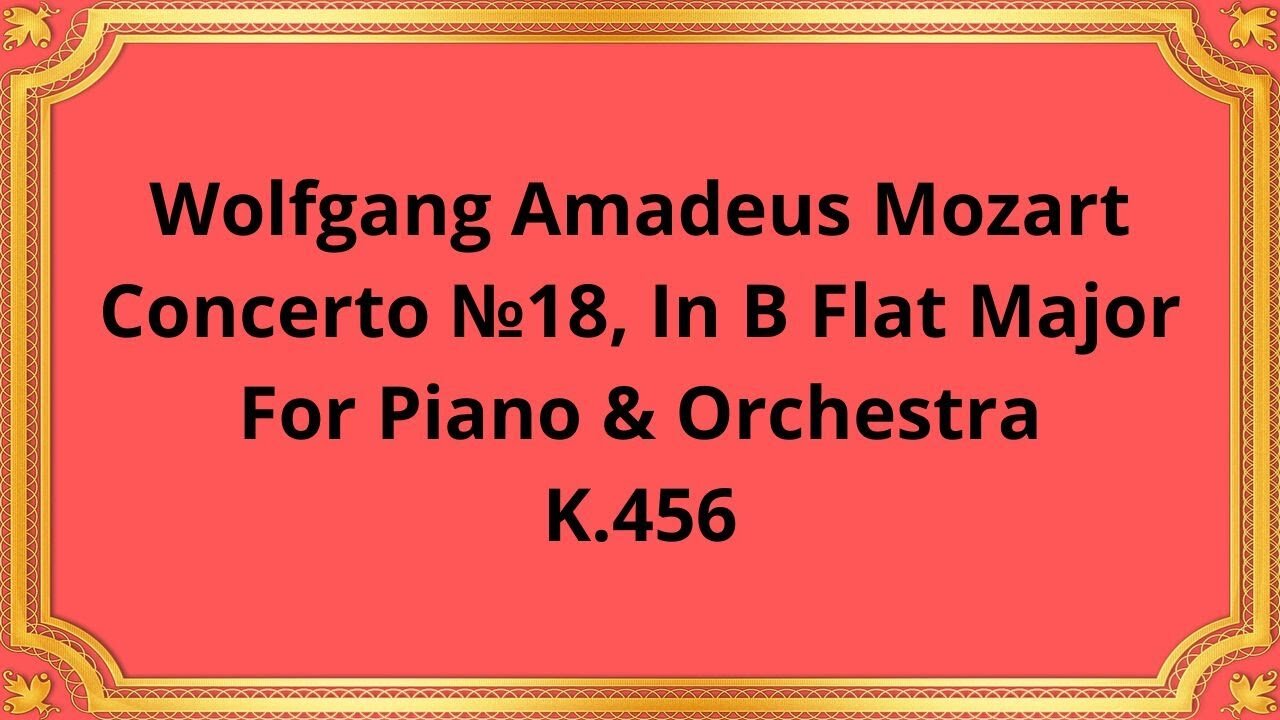Premium Only Content

Wolfgang Amadeus Mozart Concerto №18, In B Flat Major, For Piano & Orchestra, K.456
#Mozart #ClassicalMusic #ConcertoNo18 #BFlatMajor #Piano #Orchestra #MusicComposition #K456 #Musician #Composer #MusicHistory #MusicPerformance #MusicAppreciation #MusicEnthusiast #MusicalGenius #BaroqueMusic #ClassicalPeriod #Mozartian #OrchestralMusic #PianoConcerto
Publication date 1965
PAUL VON SCHILHAWSKY, PIANO UNDER THE DIRECTION OF RUDOLF ALBERT
Wolfgang Amadeus Mozart, a musical genius of the Classical era, composed numerous remarkable works that continue to captivate audiences today. Among his vast repertoire, Concerto No. 18 in B Flat Major for Piano and Orchestra, K.456, stands as a shining example of his unparalleled talent and innovative musical style.
Composed in 1784, during Mozart's prolific years in Vienna, Concerto No. 18 represents a significant period in the composer's life. This was a time of immense creativity for Mozart, and his works were highly sought after by aristocratic patrons and the general public alike. The concerto was written during the height of the Classical period, a time characterized by elegance, balance, and restraint in musical expression.
Concerto No. 18 is composed in three movements, adhering to the traditional concerto form. The first movement, Allegro vivace, opens with a spirited orchestral introduction, setting the stage for the grand entrance of the piano. The piano and orchestra engage in a lively dialogue, showcasing Mozart's mastery of counterpoint and his ability to create intricate musical textures.
The second movement, Andante un poco sostenuto, provides a moment of respite with its serene and introspective character. Here, Mozart displays his gift for writing beautiful melodies, as the piano and orchestra engage in a heartfelt conversation filled with tender expression.
The final movement, Allegro vivace, returns with a burst of energy, showcasing Mozart's playful and virtuosic writing. The piano and orchestra engage in a spirited dialogue, exchanging melodic fragments and showcasing the technical prowess of the soloist. The movement concludes with a triumphant and exhilarating finale.
Mozart's Concerto No. 18 in B Flat Major is a work that elicits a myriad of emotions from its listeners. The first movement exudes a sense of joy and youthful exuberance, with its lively melodies and playful interplay between the piano and orchestra. The second movement, on the other hand, evokes a profound sense of introspection and emotional depth, with its tender and melancholic melodies. The final movement, with its energetic and virtuosic passages, leaves the audience exhilarated and in awe of Mozart's technical brilliance.
Conclusion:
Mozart's Concerto No. 18 in B Flat Major, K.456, stands as a testament to his exceptional musical talent and his ability to create works that continue to resonate with audiences centuries later. Its historical significance, intricate musical structure, and emotional impact make it a masterpiece of the Classical era. Whether performed in grand concert halls or enjoyed through recordings, this concerto serves as a timeless reminder of Mozart's enduring genius and his contributions to the world of classical music.
You have the opportunity to support the channel:
https://destream.net/live/RadSiarAl/donate
https://www.buymeacoffee.com/6355radsiaral
-
 23:19
23:19
Classical music_Music Inspiration
3 days agoLudwig van Beethoven Sonata No. 23 in F minor, Op. 57 "Appassionata"
231 -
 5:59:47
5:59:47
SpartakusLIVE
7 hours agoThe HUGEST Brain (not forehead) delivers Saturday SPARTOONS || Variety Later - Shadow of Mordor
176K4 -
 2:34:20
2:34:20
Barry Cunningham
8 hours agoPRESIDENT TRUMP WELCOMES FOOTBALL SEASON! AND MORE BREAKING NEWS!
63.6K38 -
 54:47
54:47
Side Scrollers Podcast
12 hours agoSide Scroller Presents KING OF THE KART | MASSIVE MARIO KART TOURNAMENT
29K -
 4:12:33
4:12:33
Mally_Mouse
12 hours ago🔥🍺Spicy HYDRATE Saturday!🍺🔥-- Let's Play: Baldur's Gate!
24.4K1 -
 2:26:32
2:26:32
BooniesHQ
7 hours agoGame Of SKATE Shaun Hover Vs. Jeff DeChesare: Boonies Skate Night 1
101K5 -
 LIVE
LIVE
MissesMaam
2 hours agoAmong Us 3D (ft. Rumblers) 💚✨
93 watching -
 LIVE
LIVE
S0lidJ
3 hours ago🟢Live - S0lidj - Solo Snipes
48 watching -
 17:08
17:08
Exploring With Nug
1 day ago $2.42 earnedMassive Thunderstorm Hits During Search for Missing Georgia Woman!
23.5K1 -
![RCP #29🤟 [FR/ENG] 🤟 Satisfactory trying to grow a beautiful Factory, possible other Game later 🤟](https://1a-1791.com/video/fww1/98/s8/1/o/q/N/d/oqNdz.0kob-small-RCP-29-FRENG-Satisfactory-t.jpg) 8:05:52
8:05:52
Deaf Gamer Girl
9 hours agoRCP #29🤟 [FR/ENG] 🤟 Satisfactory trying to grow a beautiful Factory, possible other Game later 🤟
1.8K